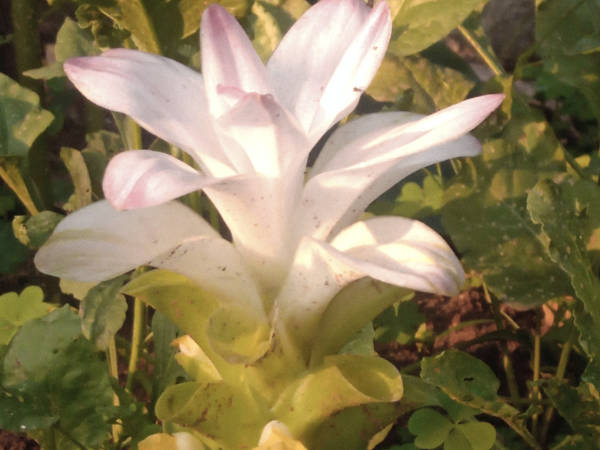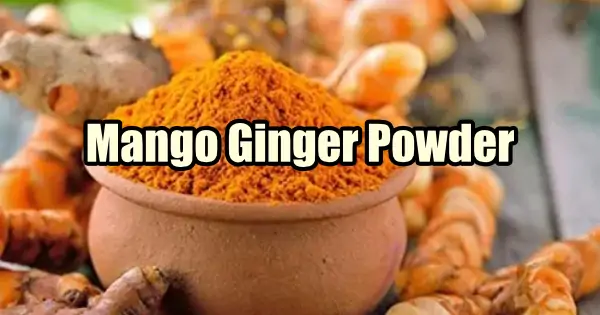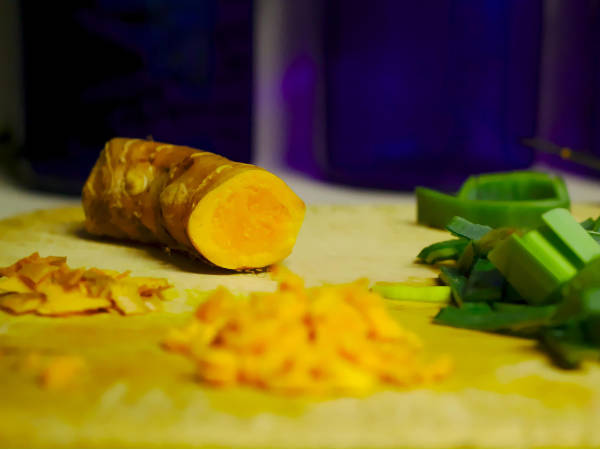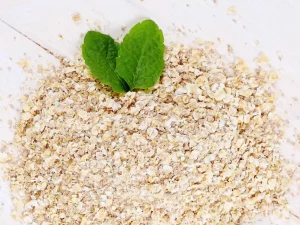Mango Ginger Benefits and Medicinal use
Do not let the name confuse you. It is neither related to Ginger nor Mangoes.

Only a ginger, can call another ginger Ginger.
Mango Ginger, also known as Curcuma Amada, belongs to the Zingiberaceae family of Ginger and is closely related to turmeric. Mango ginger’s rhizomes are similar to ginger, but they do not have a pungent smell like ginger. Instead, mango ginger has more of a raw Mango flavor; hence it is called “Mango Ginger.” For Mango ginger, health benefits, and uses, keep reading to discover traditional medicinal uses and health benefits of mango ginger, aka Curcuma Amada.
Mango Ginger’s most common use is to make pickles in south India. And like mango-ginger elephant foot yam pickle is also famous in south Nepal.
Curcuma Amada is a famous spice and vegetable due to its unique flavor, sweet with subtle earthy floral and pepper overtones with some similarities to raw mango.
Mango Ginger Description
Mango Ginger is a rhizome that is pale yellow on the inside and lighter yellow on the outside. It does not have the pungent smell of ginger, but it gives a raw mango smell when it is crushed.
Its shape is in between ginger and turmeric. The inside (flesh) lacks fiber or thread-like content as turmeric and ginger.

The flowering stage or Blooming stage starts in the middle of the rainy seasons of Asia. Mango-Giger’s flowers have a sweet taste.
Mango Ginger Common Names
The scientific name of “Mango Ginger” is “Curcuma amada,” and the word amada means “Mango Like” in Bengali. Below are some familiar names for Curcuma Amada:
- In Hindi/Urdu, it is called “Amba Haldi” or referred to as “Wild Turmeric”
- Marathi: Amba Haldar
- Gujarati: Kannada
Mango Ginger (Curcuma amada) Health Benefits
Curcuma amada is a spice that is used in many curry dishes. It has a warm, spicy flavor that is perfect for adding a bit of flavor to your meals.

Curcuma amada is also a great way to add health benefits to your meals. Curcuma amada is a member of the ginger family and is used as a spice in many cuisines worldwide. It is most commonly found in Indian and Thai cuisine but can also be found in dishes across Europe and the Americas.
Cytotoxic activity against breast cancer cells
Mango Ginger or Curcuma Amada is widely used in traditional medicine methods of “Ayurveda” and “Unani” treatment for cancer cure. Below are a few modern-day scientific validations of Curcuma amada’s ability to fight against breast cancer cell lines.
A study was conducted on the methanolic extract of leaves and rhizomes of Curcuma Amada to see the effects of Cytotoxic activities against breast cancer cell lines.

The objective of this study was to evaluate methanol extract taken from leaves and rhizomes of mango ginger for their cytotoxic activity against Breast Cancer cell lines MDA MB 231 and MCF-7.
This study employed different staining methods, such as acridine orange/ethidium bromide, ethidium bromide, Hoechst 33342, propidium iodide, and Giemsa, to study the mechanism of breast cancer cell death induced by this methanolic extract.
This study proved that the methanol extract of Curcuma Amada’s leaves and rhizomes showed potent cytotoxicity towards breast cancer cell lines MCF-7 and MDA MB 231.The Methanolic extract was less cytotoxic towards non-cancerous breast cell line HBL-100.
- Source
- Jambunathan, Sivaprabha et al. “Cytotoxic activity of the methanolic extract of leaves and rhizomes of Curcuma amada Roxb against breast cancer cell lines.” Asian Pacific journal of tropical medicine vol. 7S1 (2014): S405-9. doi:10.1016/S1995-7645(14)60266-2
Another study on the cytotoxic behavior of crude methanol extract was tested against six human cancer cell lines using an in-vitro neutral red cytotoxicity assay.
- Hormone Dependent Breast cell line (MCF-7)
- Colon cell lines (HCT 116 and HT-29)
- Cervical cell line(Ca Ski)
- Lung cell line (A549)
- Nasopharyngeal Epidermoid cell line (KB)
- Non-Cancer Human fibroblast cell line (MRC-7)
Less toxic to non-cancer cells
In this study, the crude methanol and fractionated extracts showed encouraging signs that mango ginger can be used to cure cancer, and it proves to be less toxic to non-cancer cells compared to “doxorubicin,” which is more effective than Curcuma amada.
- Source
- Malek SN, Lee GS, Hong SL, Yaacob H, Wahab NA, Faizal Weber JF, Shah SA. Phytochemical and cytotoxic investigations of Curcuma mangga rhizomes. Molecules. 2011 May 31;16(6):4539-48. doi: 10.3390/molecules16064539. PMID: 21629182; PMCID: PMC6264423.
Summary: The study indicated that the methanol extract from rhizomes and leaves of Mango Ginger (Curcuma Amada) had Anti-cancer properties and possessed Cytotoxic Activity against cancer cells.
Mango Ginger Health Benefits and Biological Activities
In Asian countries, Ginger, Garlic, and Turmeric hold a very high position in healthy food and culinary. Mango-Ginger is no exception to that, and it is vastly used to make pickles and chutneys. Due to its healthy bioactivities, it is often added to salad and stirs fries.
Mango Ginger includes the following biological activities which make it a healthy choice for daily diet:
- Anti-Inflammatory Properties
- Antioxidant Properties
- Antibacterial Activities
- Antifungal Activities
- Cytotoxicity Properties
- Antiallergic properties

Being a close relative to Ginger and Turmeric, it has almost all of the health properties of both.
Due to these anti-inflammatory, antioxidant, and antibacterial properties, it has been and is still in use by traditional medication methods of “Ayurveda” and “Unani” medicines.
Curcuma Amada uses in Traditional remedies
Following are some of the traditional medicinal uses of mango ginger due to its anti-inflammatory, antifungal, and antiallergic properties.
- Applying the paste of mango ginger leaves and its rhizome on Boils may relieve pain, remove puss, and cure boils.
- Mango Ginger powder and Egg white paste are used to embrocate on minor wounds, bruises, and injuries for faster recovery and to avoid inflammation and fungal activities.
- Curcuma amada’s powder is also used to clean teeth and fix lousy breath and taste.
- Mango Ginger Powder has also been used in face creams to enhance face color and to add glow to the face.
- The use of Curcuma Powder helps wounds heal faster.
- Black Salt and Curcuma amada’s powder is eaten to relieve abdominal pains. About half a teaspoon.
- Pink Salt and Curcuma amada’s powder has been proven to relieve fever due to dry cough and as well as it can remove mucus from the lungs.
Curcuma Amada use may help with Obesity and Memory Impairment
Curcuma Amada had compounds that could help with Obesity and Memory Impairment conditions.
For that, a study was conducted on rats to evaluate the anti-obesity and anti-amnesic properties of Curcuma amada using a high-fat and high-sugar (HFHS) diet.

This study concluded that Mango Ginger (Curcuma Amada) use could attenuate or reverse the effects of obesity, memory loss, neuro-degeneration, and oxidative stress caused by High-Fat and High-Sugar diets.

This study on rats shows potential treatment alternatives for obesity and memory loss patients.
- Source
- Lakshmi Sudeepthi Nissankara Rao, Eswar Kumar Kilari & Phani Kumar Kola (2021) Protective effect of Curcuma amada acetone extract against high-fat and high-sugar diet-induced obesity and memory impairment, Nutritional Neuroscience, 24:3, 212-225, DOI: 10.1080/1028415X.2019.1616436
Conclusion
Like other species of Curcuma, Curcuma amada, also known as Mango ginger, is famous in Asian countries, especially in southern India, for its use as pickles and as an alternate medication for inflammation, bacteria, fungal and allergic treatments.
In general, using mango-ginger pickles or fresh slices in salads gives the energy to keep the body’s thermogenic in check and keeps body cells free from different chronic diseases.
All edible species of Curcuma are an excellent source of carbohydrates, proteins, dietary fiber, and vitamins and minerals.
Curcuma Amada Nutrients
Studies on the nutritional values of Curcuma amada have shown that the plant is nutritionally rich, containing sugars, fibers, essential oils, starch, proteins, amino acids, minerals like iron, zinc, copper, molybdenum, calcium, manganese, phosphorous, nitrogen, potassium, chromium, magnesium, sodium, and sulfur as well as vitamins like thiamine, riboflavin, vitamin A, niacin, pyridoxine, vitamin C, and vitamin E. [1, 2, 3, 4]
Due to the presence of calcium, iron, potassium, magnesium, sodium, copper, manganese, and zinc, the rhizomes of Curcuma amada are also used in Chinese Pharmacopeia as a health food and a supplement. [5-6]
1 – Jagtap, S.;, Phytochemical Screening, Anti-Oxidant Activity, Multi-Elemental Analysis by ICP- Spectroscopy and Antimicrobial Activity of Rhizome Extracts of Curcuma pseudomontana J. Grahm, Eur. J. Biomed. Pharm. Sci., 2015, 2(4), 1152–1169.
2 – Sharma, G. J.; Chirangini, P.; Kishor, R. Gingers of Manipur: Diversity and Potentials as Bioresources. Genet. Resour. Crop Evol. 2011, 58, 753–767.
3 – Sajitha, P. K.; Sasikumar, B., Qualitative and Quantitative Variation in Starch from Four Species of Curcuma, Cytologia, 2014, 80(1), 45–50.
4 – Ibrahim, H.; Jansen, P. C. M. Curcuma Roxburg. In Plant Resources of South East Asian No.9. Plants Yielding Non-Seed Carbohydrates; Flach, M., Rumawas, F. Eds.; Prosca Foundation: Boogor, 1996; pp. 72–78.
5 – Wang, Y.; Wang, M. Z. The Research Progress of Curcuma. Chin. Pharm. J. 2001, 36, 80.
6 – Tian, Y. M.; Zhou, D.; Zhang, W.; Cheng, C. G., Comparison and Correlative Analysis of Trace Elements in Five Kinds of Radix Curcumae, Guang Pu Xue Yu Guang Pu Fen Xi, 2008, 28(9), 2192–2195.








One Comment
Comments are closed.